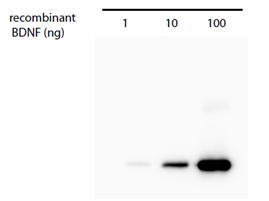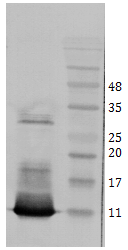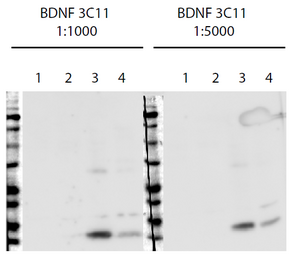Otsi
Otsi



Figure 3. Western Blot testing of anti-BDNF monoclonal antibody 3C11. Antibody concentrations of 1 µg/ml and 0.2 µg/ml was used. 20 µg of cell lysate was loaded per lane. Lanes 1 and 2 – rat astrocytes’ culture preparation. Lanes 3 and 4 – rat hippocampal neuron culture lysate. Photo courtesy of Indrek Koppel and Tõnis Timmusk, Tallinn Technical University, Institute of Gene Technology.
Catalogue #
327-100
Name
Mouse mAb to hBDNF (clone 3C11)
Target
Human BDNF
Target Description
Recombinant mature human BDNF protein produced in E. coli
Alternative Names
Abrineurin
Uniprot ID
P23560
Clonality
Mouse monoclonal
Clone
3C11
Class
mIgG1
Reactivity
human, mouse, rat, guinea pig
Application
ELISA, WB, IF
Protocol
ELISA:
0,02-1 µg/ml
WB:
0,1-1 µg/ml under reducing conditions
IF:
2-20 µg/ml
Purification
Protein G purified
Buffer
PBS pH 7.4, with 0.1% sodium azide.
Shipping
This product is shipped in non-frozen liquid form in ambient conditions
Storage
Store at -20… -70 °C upon receipt. Divide antibody into aliquots prior usage. Avoid multiple freeze-thaw cycles.
Background
Brain-derived neurotrophic factor (BDNF) plays an important role in activity-dependent synaptic plasticity such as long-term potentiation. BDNF acts on certain neurons of the central nervous system and the peripheral nervous system, helping to support the survival of existing neurons, and encourage the growth and differentiation of new neurons and synapses
References
Zunino, G. Messina, A. Sgadò, P. Baj, G. Casarosa, S. Bozzi, Y. Brain - derived neurotrophic factor signaling is altered in the forebrain of Engrailed-2 knockout mice.
Neuroscience. 2016 Mar 14
This product is for research use only
TECHNICAL ASSISTANCE
Please refer any technical questions to
technical.support@icosagen.com